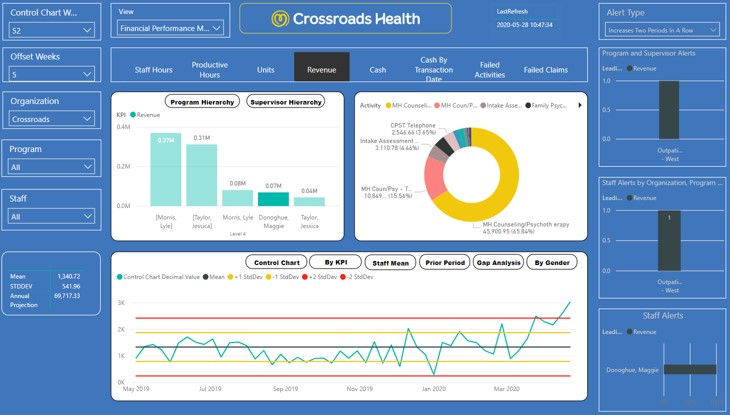iCentrix Client Presentation at OPEN MINDS Institute - Alexander Youth Networks
- Doug
- Mar 18, 2021
- 4 min read
Tech for VBR—It’s All About The Data
March 17, 2021 | Monica E. Oss
As payers move to more value-based contracting, the question for most provider organization executive teams is whether their organization is prepared to succeed in a world that moves past fee-for-service. One key ingredient in that preparation is an adequate technology infrastructure. That was the focus of the session Does Your Organization Have The Right Technology To Be Successful With Value-Based Reimbursement? led by my colleague and OPEN MINDS Senior Associate Ken Carr at the recent OPEN MINDS Technology & Analytics Institute. He said, “In moving from fee-for-service models to VBR, provider organizations have to make the leap from a commodity approach (getting paid for delivering a service) to an outcomes approach (getting paid for making an impact). That requires a shift in business model and a shift in technology. Organizations need the right technology to drive outcomes and demonstrate those outcomes.”
Joe Dan Beavers, President and Chief Executive Officer of LifeSkills, Inc. and Carolyn Spence, Chief Information Officer of Alexander Youth Network (AYN) joined Mr. Carr in the session. They presented case studies of their organizations—and their current (and ongoing) journey from fee-for-service models to reimbursement based on value. Both executives outlined their path to success and their investments in technology—and both agreed that it’s not the technology per se, but the data that is the linchpin.
LifeSkills, a community mental health center in Kentucky, grew from a base of 95,000 to 450,000 Medicaid consumers in recent years. They have multi-year contracts with health plans that are moving from fee-for-service to full risk sharing over the course of the next two to three years. Alexander Youth Network (AYN), based in North Carolina, serves about 10,000 children and youth a year through 150 foster homes across the state. Their VBR contracts span a wide range of reimbursement models.
The panelists identified three keys for success in scaling and managing technology and data for VBR—asking the right questions; sharing the right story with the right customers; and getting the right people, process, and product.
What do you want to know?
While there is no dearth of data collected by provider organizations, leveraging data for VBR success has to start with asking the right questions. Ms. Spence provided some examples of insights from AYN’s data analytics forum that helped to improve efficiencies, enhance outcomes, and achieve cost savings. Asking what was happening with their consumers outside their care system helped them get information—through the state health information exchange—on consumer hospital admissions, visits to primary care and other provider organizations, interactions with pharmacies, and even immunization records—to gain a holistic view of consumer needs. They also get real time notifications when something happens and that’s been valuable, according to Ms. Spence. Asking why their no-show rates were high led to data analysis that showed the highest no-shows during specific appointment time blocks—so changing office hours dramatically improved access to services and engagement. And trying to understand who the high-risk, high-utilizing consumers are has helped clinical leaders change the course of treatments and achieve costs savings. For example, looking at “key influencers” for increased length of residential stays helps the clinical team ask if they have the right levels of care and the right approaches or if they need to do more to reduce the length of stay.
Ms. Spence said, “The biggest part of building useful dashboards is understanding what kind of data you want to capture, how do you want to measure it, and what to do about outcomes that are not desirable. And we always ask if we can drill through and figure out correlations.”

What is the story you want to tell, and to whom?
Data has to be shared with the right stakeholders at the right time to demonstrate value and improve outcomes. Mr. Beavers said, “You have to use your data to tell a story. And you have to keep it simple and make it actionable—whether it’s to help staff do their jobs better or to demonstrate outcomes to payers.” It’s also important to know your data and to think about what the recipient of information would like to know. “You’ve got to know your own data cold and have a high degree of confidence in it. How we operate is important to us, but we also have to understand the MCO angle and speak their language,” Mr. Beavers added. At LifeSkills, conversations about leveraging technology to share data across multiple provider organizations have paved the way for strong partnerships and affiliations.
Ms. Spence agreed, “We’ve been able to measure different types of outcomes based on different types of assessments that we’re doing. And that has afforded us the ability to talk to our managed care organizations a little bit more about what we can do and what we offer, what our models of care are, and what impact are these models having.” She emphasized that with the performance-based type of contracts that use scorecards, provider organizations must review their data and be able to address any discrepancies in their system versus the payers’ systems.
AYN has also created some dashboards that they use with families during child and family team meetings, so family members can actually see if the children are improving on their goals, month to month. “Having that visual representation for the families is an interesting because now it’s not just stories, but they can actually see that the bars are improving,” Ms. Spence said.



Comments